Imagine coming home to find water everywhere.
This unexpected disaster can cause significant damage, leaving homeowners overwhelmed and stressed about the recovery process.
Water damage needs to be addressed immediately to minimize larger issues such as mold growth, structural decay, and electrical hazards that could arise if ignored. A professional water damage removal service is your best partner in restoring your home back to its original condition efficiently.
Here is what to know.
Causes of Water Damage
Water damage can originate from various sources, a spectrum of unanticipated circumstances, making each case unique. Common causes of water damage include natural disasters like floods and storms, faulty plumbing systems leading to leaks, overflowing appliances such as dishwashers or washing machines, and even roof damage that allows rainwater to seep in. Understanding these causes is essential in preventing future occurrences and ensuring a swift response if water damage does impact your property.
Common Household Sources
One of the most common household sources of water damage is leaky pipes. These issues can often go unnoticed until significant damage has occurred, so regular maintenance is key.
Another frequent culprit is malfunctioning household appliances, such as washing machines and water heaters. When these devices fail or develop leaks, they can quickly cause extensive water damage.
Washing machines alone account for over $170 million in water damage claims annually.
Roof leaks are another major source of water damage in homes. Missing shingles, clogged gutters, or cracked flashing can all lead to water infiltrating your home during heavy rains, resulting in costly repairs. Early detection and routine inspections are crucial in preventing such issues.
Natural Disasters
Natural disasters can cause catastrophic water damage to homes, disrupting lives and displacing residents.
Floods and hurricanes, for instance, bring tremendous volumes of water.
This water can overwhelm drainage systems and breach protective barriers, resulting in flooded basements, damaged foundations, and ruined personal property.
In the aftermath of such events, it’s essential to act quickly to remove water and begin restoration. The timely intervention of water damage removal services can prevent further deterioration, reduce health risks from mold and mildew, and help restore your home to its former state. They stand ready to tackle these challenges, ensuring a comprehensive and efficient recovery process.
Immediate Steps to Take
Upon discovering water damage, removing excess water should be your top priority. Use towels, mops, and wet-dry vacuums to soak up any standing water.
Additionally, move any furniture or items off the floor to prevent further damage and allow the area to dry more efficiently.
Safety Precautions
Prioritize safety to protect yourself and your property during water damage removal.
- Turn off Electricity: Prevent electrical hazards by switching off power to affected areas.
- Wear Protective Gear: Use gloves, boots, and masks to safeguard against contaminants and debris.
- Avoid Floodwaters: Stay clear of potentially hazardous floodwaters that may carry harmful substances.
- Ventilate the Area: Open windows and use fans to improve air circulation and reduce mold growth risks.Taking these precautions ensures a safer environment for everyone involved.
Adherence to these steps significantly minimizes potential dangers.
Initial Cleanup
Starting the initial cleanup is essential to preventing further damage from water intrusion and should be done promptly to save time, money, and stress.
Removing standing water quickly ensures that moisture doesn’t have a chance to cause additional issues.
Use absorbent materials like towels or mops for smaller areas, and consider renting a wet-dry vacuum for larger spaces. This approach will help to remove as much water as possible and begin the drying process.
Once the water is tackled, clean and disinfect all affected areas to prevent mold and mildew growth. It is crucial to use appropriate cleaning agents and follow proper guidelines to ensure your space is thoroughly sanitized.
Choosing a Professional Service
Selecting a professional service for water damage removal is paramount to achieving efficient and thorough restoration. Look for companies that have certifications, solid reviews, and well-trained staff to ensure optimal results.
Reputable companies offer prompt responses and quality equipment, and they understand the urgency of water restoration.
What to Look For
Finding the right water restoration service.
First and foremost, seek out companies with accredited certifications. These credentials indicate adherence to industry standards and a commitment to quality. Certified technicians possess the expertise necessary to handle complex water damage removal tasks. Additionally, take note of the company’s experience in the field and their track record of successfully managing similar cases.
Check for positive reviews.
Customer testimonials can provide valuable insights into the reliability and professionalism of a service. Look for detailed feedback that highlights the company’s efficiency, transparency, and communication skills.
Evaluate their emergency response capabilities.
Determine whether the water damage removal service is available 24/7. Prompt action is crucial, so a service that can respond immediately will significantly minimize damage and begin the restoration process quickly.
Finally, inquire about their equipment and techniques. Modern, high-quality tools are essential for effective water damage removal and complete restoration. Ensure the service employs advanced technology and follows up-to-date methods to deliver the best results. With these criteria, you will be well-prepared to choose a service that meets your restoration needs.
Questions to Ask
When considering a water damage removal service, it’s crucial to ask the right questions. Start by finding out about their experience and expertise. How long have they been in business? Experience often equates to better service.
Inquire about certifications. Are the technicians certified by the Institute of Inspection, Cleaning and Restoration Certification (IICRC)?
Next, ask about their availability for emergencies. Can they respond promptly 24/7 to ensure minimal damage?
Investigate their customer service approach. How do they communicate and update clients throughout the restoration process?
Don’t forget to ask about the equipment and techniques they use. Are they employing the latest technology and industry-standard methods for water damage removal and restoration?
Lastly, try to understand their process. What steps do they take from inspection to the final restoration? Clarity in their procedure can give you peace of mind and set expectations right.
Restoration Process
Experts tailor the restoration process to address specific water damage scenarios and ensure complete water restoration. Usually, it includes inspection, water extraction, drying, dehumidification, cleaning, and sanitization before final restoration.
Each restoration stage employs cutting-edge equipment to efficiently mitigate damage, making the entire process swift and effective.
Drying and Dehumidifying
Essential steps involve thorough drying and dehumidification.
Once the water is removed, the drying begins. This crucial phase can take time but ensures that unseen moisture within floors, walls, and other hidden areas is effectively eliminated. Dehumidifiers, fans, and air movers play an essential role in expediting this part of the water restoration process.
Every area is carefully monitored.
The equipment used is top-notch, ensuring every nook and cranny is dry — essential for preventing mold growth that could occur if any moisture remains — thus ensuring a healthier environment post-restoration.
By choosing water damage removal services with expertise in drying and dehumidifying, customers can rest assured knowing their properties are in capable hands. These professionals leverage advanced technology, patience, and thoroughness to return spaces to their dry, pre-damage states.
Mold Prevention
Mold is a common concern after water damage, but with the right steps, it can be effectively prevented. Quick response is the key.
Immediate action reduces the risk of mold growth significantly.
Proper drying ensures that any remaining moisture is eliminated.
Using dehumidifiers helps reduce humidity levels.
Continuous monitoring is essential, as mold can start developing within 24-48 hours. Regular inspections help catch any early signs.
Prevention is always better than cure in the case of mold. Trusting professionals with mold prevention measures reduces worry and ensures a safer environment.
What is the difference between remediation and restoration?
Remediation focuses on stopping further damage and addressing the root cause of the problem. It often includes cleaning, sanitizing, and decontaminating affected areas to ensure a safe environment. Professionals may use specialized tools and techniques to remove hazardous materials, such as mold or asbestos.
Restoration, on the other hand, involves returning a property to its pre-damage condition. This process may include rebuilding structures, replacing damaged materials, and making repairs to bring the space back to its original state. The goal is to make it seem as if the damage never occurred.
While remediation is about halting the source of the damage and making the area safe, restoration is more comprehensive in repairing and rebuilding the affected areas. Both processes are essential to returning a property to normal.
Ultimately, effective water damage management requires a combination of remediation and restoration. Each step plays a crucial role in protecting health and property value.
For those tackling water damage, understanding these distinctions can help achieve optimal results.
What should I do immediately after water damage?
Quick action is essential when dealing with water damage. First, ensure the safety of everyone in the affected area. Turn off the electricity and avoid any contact with potentially contaminated water.
Next, identify the water source and shut it off if possible to prevent further damage. Make a note of any visible damage and take photographs to document the extent; this will be helpful for insurance claims.
Then, remove any valuable items and furniture from the affected area to prevent further damage. Place them in a dry, safe location and begin drying out the space using fans or dehumidifiers if available.
Finally, it’s crucial to contact a professional water restoration service as soon as possible. Their expertise will help ensure all moisture is removed, preventing mold growth and further structural damage. Engage with a trusted service provider to restore your property efficiently and effectively.

